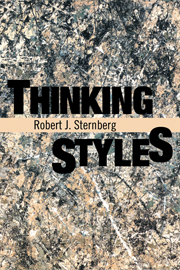Book contents
- Frontmatter
- Contents
- Preface
- Part I The Nature of Thinking Styles
- Part II The Principles and Development of Thinking Styles
- Part III Thinking Styles in School and in Research and Theory
- 7 Thinking Styles in the Classroom: What Have We Learned?
- 8 A Capsule History of Theory and Research on Styles
- 9 Why a Theory of Mental Self-government?
- Notes
- Index
7 - Thinking Styles in the Classroom: What Have We Learned?
Published online by Cambridge University Press: 05 August 2012
- Frontmatter
- Contents
- Preface
- Part I The Nature of Thinking Styles
- Part II The Principles and Development of Thinking Styles
- Part III Thinking Styles in School and in Research and Theory
- 7 Thinking Styles in the Classroom: What Have We Learned?
- 8 A Capsule History of Theory and Research on Styles
- 9 Why a Theory of Mental Self-government?
- Notes
- Index
Summary
We have studied thinking styles in classrooms in order to confirm our view that they make a practically important difference to school performance. How do they make such a difference?
STYLES OF THINKING IN INSTRUCTION AND ASSESSMENT
For those who teach and assess students at any level – young children, adolescents, or adults – the theory of mental self-government implies modes of rendering teaching more effective. The key principle is that in order for students to benefit maximally from instruction and assessment, at least some of each should match their styles of thinking. I would not advocate a perfect match all the time: Students need to learn, as does everyone, that the world does not always provide us with a perfect match to our preferred ways of doing things. Flexibility is as important for students as for teachers. But if we want students to show what they truly can do, match of instruction and assessment to styles is essential.
Table 7.1 shows various methods of instruction and the thinking styles that are most compatible with them. The major point of this table is that different methods of instruction work best for different styles of thought. If a teacher wants to reach and truly interact with a student, he or she needs the flexibility to teach to different styles of thinking, which means varying teaching style to suit different styles of thought on the part of students.
By far the most common form of instruction in schools is the lecture.
- Type
- Chapter
- Information
- Thinking Styles , pp. 115 - 132Publisher: Cambridge University PressPrint publication year: 1997



